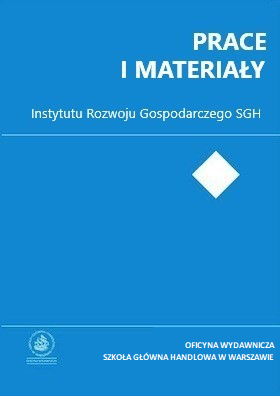The Viterbi Paths in an Analysis of Business Cycle Synchronization
##plugins.themes.bootstrap3.article.main##
Abstrakt
In the paper we investigate possibility of using the Viterbi paths to analyze two-dimensional macroeconomic time series. We build a two-dimensional Gaussian Markov-switching model with a four-state hidden Markov chain. The model is tested with two pairs of monthly indexes of industrial production for: Poland vs. France, and Poland vs. Germany. The most likely sequence of states of the hidden Markov chain is found for each pair. We compare that sequence with analogous sequences determined for a one-dimensional model with a two-state hidden Markov chain. The results of the comparison suggests the four-state Viterbi path provides more valuable information about business cycle synchronization between the two economies than two separate two-state Viterbi paths. (original abstract)
##plugins.themes.bootstrap3.article.details##
Bibliografia
Artis, M. J., Krolzig, H-M., Taro, J. (2004). The European business cycle, Oxford Papers, 56 (1), 1-44.
Bernardelli, M. (2015). The procedure of business cycle turning points identification based on hidden Markov models, Prace i Materiały Instytutu Rozwoju Gospodarczego IRG, 96, 5-23.
Bernardelli, M., Dędys, M. (2012). Ukryte modele Markowa w analizie wyników testu koniunktury gospodarczej, Prace i Materiały Instytutu Rozwoju Gospodarczego SGH, 90, 159-181.
Boldin M. D. (1996). A check on the robustness of Hamilton’s Markov Switching Model Approach to the Economic Analysis of the business cycle, Studies in Nonlinear Dynamics and Econometrics, 1 (1), 1-14.
Boldin, M. (1994). Dating turning points in the business cycle, Journal of Business, 67 (1), 97-131.
Çakmaklı, C., Paap, R., van Dijk, D. (2013). Measuring and predicting heterogeneous recessions, Journal of Economic Dynamics & Control, 37 (11), 2195-2216
Cappé, O, Moulines, E., Rydén, T. (2005). Inference in hidden Markov models, New York: Springer.
Chauvet, M., Hamilton, J. D. (2005). Dating business cycle turning points, NBER Working Paper no. 11422.
Dufrénot, G., Keddad, B. (2014). Business cycle synchronization in East Asia: A Markov switching approach, Economic Modelling, 42, 186-197.
Hamilton, J. D. (1989). A new approach to the economic analysis of non-stationary time series and business cycle, Econometrica, 57 (2), 357-384.
Hamilton, J. D. (1994). Time series analysis, Princeton, NJ.
Harding, D., Pagan, A. (2012). A comparison of two business cycle dating methods, Journal of Economics & Control, 27 (9), 1681-1690.
Matas-Mir, A., Osborn, D. R., Lombardi, M. J. (2008). The effect of seasonal adjustment on the properties of business cycle regimes, Journal of Applied Econometrics, 23 (2), 257-278.
Moolman, E. (2004). A Markov switching regime model of South African business cycle, Economic Modelling, 21 (4), 631-646.
Phillips, K. L. (1991). A two-country model of stochastic output with changes in regime, Journal of International Economics, 31 (1-2), 121-142.
Simpson, P. W., Osborn, D. R., Sensier, M. (2001). Modelling business cycle movements in the UK economy, Economica, 68 (270), 243-267.
Smith, P. A., Summers, P. M. (2005). How well do Markov switching models describe actual business cycles? The case of synchronization, Journal of Applied Econometrics, 20 (2), 253-274.
